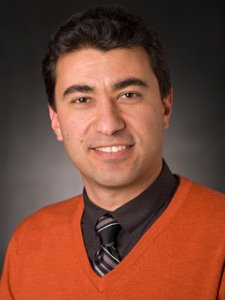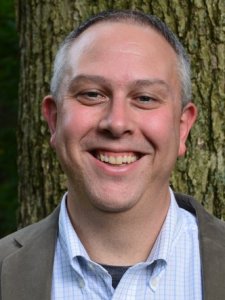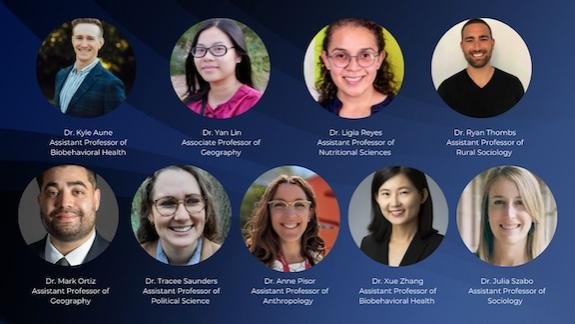IEE faculty, staff, and projects in the news
New 'collaborative hub' showcases College of Engineering's West Campus expansion
| psu.edu
The newly constructed Engineering Collaborative Research and Education Building (ECoRE), the latest expansion for the College of Engineering on West Campus at Penn State University Park, is a showcase for collaboration, both in how it was built and how it will be used by faculty, staff and students at the University.
Mentions
-
James Freihaut
-
Enrique Gomez
-
Farshad Rajabipour
-
Neeli Bendapudi
 Neeli BendapudiPresident, Penn State
Neeli BendapudiPresident, Penn State -
Tonya Peeples
Three projects receive Huck Innovative and Transformational Seed Fund grants
| psu.edu
The Huck Innovative and Transformational Seed (HITS) Fund initiative has awarded three high-risk, potentially high-impact project seed funding.
Mentions
-
Patrick Drew
-
John Tooker
-
Tanya Renner
-
Fang "Rose" Zhu
 Fang "Rose" Zhu
Fang "Rose" Zhu -
William Hancock
-
Howard Salis
Are lawsuits effective ways to protect the climate and environment?
Lawsuits are a method used by numerous groups to try to protect the climate and environment, from suing governments to accusing companies of misleading marketing. We spoke with Hannah Wiseman, an IEE faculty member and professor of law at Penn State Law, about these lawsuits and their impact on the environment and climate.
Climate-focused art, writing exhibition features works from Arctic expedition
| psu.edu
Hester Blum, professor of English at Penn State, is co-curating a climate-focused exhibition that will feature the work of artists, writers and researchers with whom she sailed on an expeditionary residency program in 2022.
Mentions
Penn State research to employ AI to monitor polluted waterways
| lancasteronline.com
Penn State received a four-year, $650,000 research grant from the U.S. Department of Agriculture to use artificial intelligence to process data on nitrate levels in the Chesapeake Bay watershed to better inform those working to cut harmful pollution in local waterways. This article features Penn State research.
Mentions
Why air pollution bamboozles pollinating bees
| bbc.com
Contaminated air is not only bad for us, it can also disrupt bees' highly attuned senses for finding flowers. This article quotes Jose Fuentes, professor of meteorology.
Mentions
$100,000 grant will advance Behrend study of smallest plastics
| psu.edu
The American Chemistry Council has awarded $100,000 to researchers at Penn State Behrend, where a team of polymer scientists is exploring the lower limits of microplastics and their potential impact in the environment, including Lake Erie.
Mentions
-
Hlengilizwe Nyoni
Assistant Research Professor, Energy and Environmental Sustainability Laboratories -
Maxwell Wetherington
 Maxwell Wetherington
Maxwell Wetherington
Growing Impact: Season 5
Our planet is at a critical crossroads. In Season 5 of Growing Impact, we delve into groundbreaking research with the power to transform our world. This season offers a deep dive into the vast and varied research at Penn State, showcasing its pivotal role in advancing a healthier planet and improving the well-being of people everywhere.
Seed Grant Projects
Nine new faculty join Penn State’s Social Science Research Institute
| psu.edu
The Social Science Research Institute (SSRI) is welcoming nine new co-funded faculty members to Penn State. By helping to support co-funded faculty members, SSRI also supports interdisciplinary research within the social and behavioral sciences.
Mentions
Todd LaJeunesse appointed to Wilson Hewitt Professorship of Biology
| science.psu.edu
Todd LaJeunesse, professor of biology, has been appointed to the Wilson Hewitt Professorship in Biology in the Eberly College of Science.
Mentions
Ask an expert: Climate, weather and energy in the 2024 presidential election
| psu.edu
With the Atlantic hurricane season in full swing and fires raging across the West Coast, the issues at stake — such as resilient infrastructure, diversifying energy sources and the preparation and response to extreme weather — affect individuals and families in Pennsylvania and across the nation, making the subjects a high priority among voters. Penn State News spoke with two faculty experts about the pressing issues surrounding climate and how it may impact voters and their families.
Mentions
USDA grant to fund project developing AI-powered database on water quality
| psu.edu
Nitrate, a common chemical compound that occurs naturally and is found in plants, water and soil, can break down into molecules harmful to human, animal and ecological health and accumulate as a pollutant. Nitrate contamination in streams, lakes and estuaries is a critical problem in many agricultural watersheds, but water-quality data is limited, making monitoring stream health and making management decisions difficult, according to researchers at Penn State. To enhance available data, the U.S.
Mentions












































